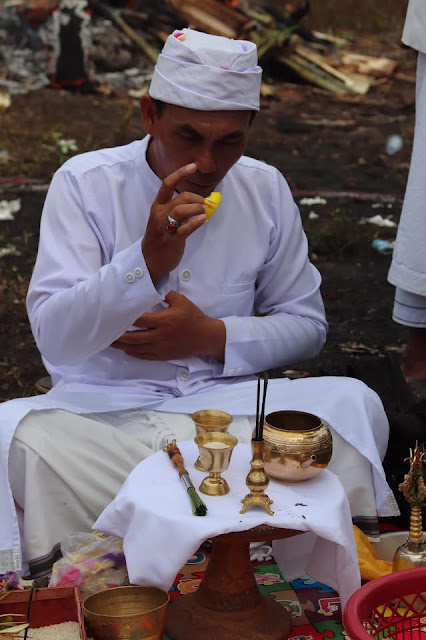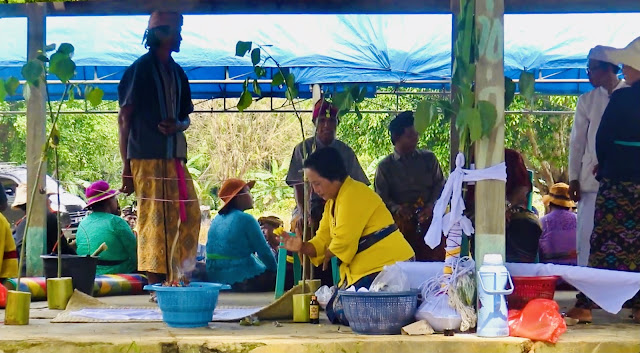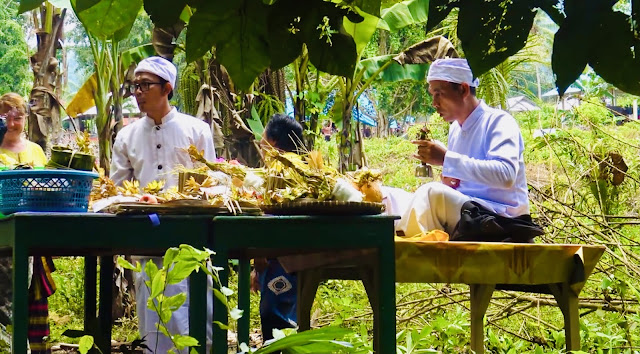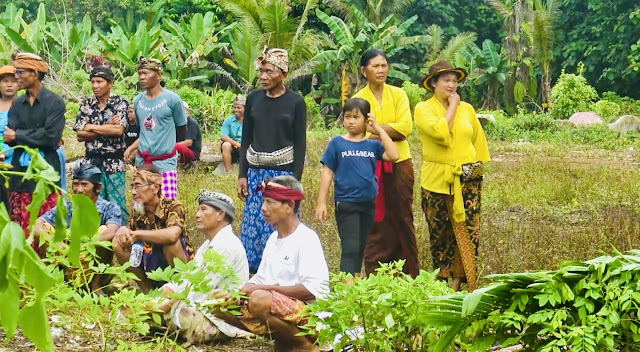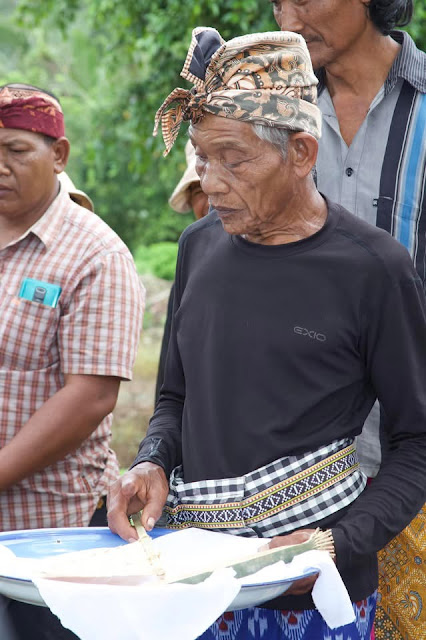We have recently reached Bau Bau on the Island of Button, Indonesia. Our days have been filled with arranging visa extensions, stocking up on supplies, and ensuring we have enough cash on hand for the next leg of our journey where card facilities are few and far between.
Although we are in Islamic Buton, our visa agent, Komang, is actually Balinese, and lives in a village of 2,000 established in the 1970s by the government to populate an area that the local Butonese saw as cursed. The Hindu Balinese have thrived, establishing a strong community largely based on rice production.
After organising the lodgement of our visa documents he mentioned a ceremony was taking place in his village the next day and would we like to see it. Always up for new experiences and despite not quite hearing what sort of ceremony, I enthusiastically agreed to attend. "I will come to pick you up at 8 am," he added, mentioning the need to wear a sarong, traditional sash, and udeng. "That's absolutely fine," I replied once more.
After Komang departed, I inquired of Rob, "What kind of ceremony did he say?" Rob reiterated, ensuring I fully heard this time, "A CREMATION CEREMONY!" Oh, that's something I must brace myself for.
Around the globe, cremation is a widely practiced ritual in various forms. Despite its commonality, the methods and reasons behind cremation differ significantly across cultures. In Western societies, the preference for cremation is increasing due to the escalating costs of traditional funerals and its comparatively lower carbon footprint. The adaptability of cremation also appeals to Western customs. Cremation urns serve as beautiful memorials, offering diverse options to honor the departed, including specialized urns for scattering ashes. On the other hand, Hindu cremations hold deep-rooted cultural significance and traditions that have been passed down for centuries.
In Hinduism, it is believed that the soul transitions to a new body after death, forming the basis for Hindu cremation funeral customs.
In Balinese society, the “funeral service” typically occurs at home, resembling a “wake” in Western tradition, where guests pay their respects and are treated to a sumptuous feast. Additionally, there is another Hindu funeral ritual called Shraddha, dedicated to deceased ancestors like fathers, grandfathers, mothers, and grandmothers. This ceremony aims to provide spiritual nourishment, protection, and guidance for the departed souls as they journey from lower to higher realms before their next reincarnation on Earth. These rites are observed between the 11th and 31st day following the passing. Unfortunately, we were not present to witness these ceremonies.
The traditional ceremony, held at the cremation site, is a centuries-old practice that we will be witnessing. After the body has been moved from the home, or in the case of this particular cremation, after the deceased has been exhumed. (This all sounded like the Tana Toraja death rituals we had recently witnessed on Sulawesi, but unlike Tana Toraja, there is no festival attached to the cremation. In truth though filled with ritual it is basic and confronting).

Families need to save for the cremation of a loved one. So the body is buried whilst they save.
The complete funeral ceremony can be quite costly, leading to a gap between the passing and the ceremony. During this time, the body is laid to rest until the Ngaben ritual. Once the necessary funds are gathered, families select an auspicious day spiritually and prepare a coffin, known as a bade, for the deceased. Only then is the Ngaben ceremony scheduled. Today, many cremations are conducted as a group event, with up to 30 individuals cremated together due to financial considerations. It was clarified that not all bodies are fully cremated during these mass cremations, which occur approximately every five years.
This story and the accompanying photographs contains graphic content from this point onward. If you’re likely to find this upsetting, we kindly request that you refrain from reading further. We approach the cultures we encounter without judgment or bias towards their traditions. Our role is simply that of observers, dedicated to sharing their stories with you.
Ngaben, meaning "turning into ash," holds significant importance in Hindu funeral rituals. According to Hindu beliefs, a person's soul remains confined within the body until a proper cremation is conducted. Through the ceremonial cremation process, the soul is liberated, enabling it to ascend to the celestial realms.
Rituals in Hindu funerals involve mantras that are specifically crafted for chanting. A number of Hindu priests serve as officiants, guiding the family and mourners through the various Hindu death customs. During this cremation ceremony for a woman that had passed away in her Seventies, the eldest son took on multiple responsibilities, assisted by the priest, as the husband, who would typically perform this role, was currently unwell.
To prepare the deceased for cremation, the body underwent a cleansing ritual, received symbolic offerings, and was dressed in traditional attire to ensure a smooth transition into the next life. Family and friends gathered to bid a final farewell and offer prayers for a safe journey. The procession then moved towards the cremation grounds, accompanied by gamelan music and singing. An interesting tradition involves rotating the corpse three times when crossing a significant road, believed to confuse malevolent spirits attempting to capture the soul of the departed.
We reached an open paddock where groups of people had already gathered under the shade of trees. However, what truly captured my attention was the area in the middle of the paddock that held my gaze. As we approached the structure, I observed the scene with keen interest. Everyone around us seemed content, engaged in cheerful conversations, and simply enjoying the surroundings.
The setup consisted of four poles supporting a tin roof, beneath which was what could be described as similar to what we would use a spit drum for roasting a pig or an open BBQ. This setup included high-powered, diesel fuelled burners boosted by an air compressor, positioned at each end to blast superheated air and intense flame. Resting on the racks between the burners was the deceased individual. There were no coverings or screens provided to hide the deceased. Everyone, including ourselves, had a full view of the scene.
The fire burned fiercely as attendants diligently fed the flames, creating intense heat. Surrounding the furnace was a marked out area, not for safety as I initially thought, but as a boundary to ward off evil spirits. Upon closer inspection, I noticed old coins threaded along the perimeter rope. The attendants continued to direct the flame onto the corpse, offering us the opportunity to move closer for a better view, which I deemed unnecessary. Despite being invited to witness the ceremony by someone closely connected to the participants, I was hesitant to capture the raw and vivid essence of the event. This was not a staged performance for tourists but a regular part of the life and death cycle of the Balinese Hindu culture in its most authentic form.
The cremation process took a unexpectedly long time but when completed, the shields were taken off to reveal the outcome, a thin layer of ash and small bone fragments laying on the corrugated iron base of the fire pit. Initially, I expected the ashes to be gathered and given to the family. However, this ceremony had more stages yet with even deeper significance.
The ashes were left in place and washed through a palm frond, before family members from the most senior, in this case the deceased’s oldest son, through to the youngest, took turns selecting a bone fragment from the left, middle and right of the fire pit which were placed in three separate piles on a tray. I found it intriguing that the family considered sifting through human ashes of the family matriarch to be nothing unusual.
Once all family members had added bone fragments to the tray they were taken to another ceremonial area. Again this area was guarded by coins to ensure evil spirits were held at bay. While the chanting and music continued, two men then went about arranging the bone fragments into a human shape on a white cloth. Pieces from the left, where the deceased’s skull had been, were used to form the head, those from the middle the body and arms, and those from the right made up the legs. The priests carried on their work of saying prayers, chanting and ringing bells. A human body shape was formed and then clothed in layers of delicately made offerings and flower petals. Once this was completed the human form was wrapped ceremonially and handed to the eldest son.
The chanting reached a crescendo as the three priests continued with their prayers. They splashed water all around, performed the ritual sacrifice of a tiny chicken, broke coconuts, and presented the water as an offering to the deities. The intensity was escalating when suddenly, the family rose and began a procession. They circled around the cremation and ceremonial site three times before leading everyone down to the river.
We anticipated witnessing the culmination of the ceremony. A priest was seated on a raised platform, reciting prayers, as his assistants carefully arranged offerings on a bamboo altar and lit incense. The family members sat together, engaging in a series of rituals. Suddenly, they rose and walked towards the riverbank. Everyone chanted mantras to purify the body and guide the soul towards the spiritual realm. A family member then unwrapped the remains and released them into the rapid current. According to Hindu beliefs, if the ashes of the deceased are immersed in water and flow downstream to finally reach the Ganges in Varanasi, their soul will transcend to heaven, breaking free from the cycle of rebirth. Once more, the family sat in silence, engaging in prayer as the priest led them through the final words to bid farewell to their beloved and guide them to a better place.
Afterward, we followed the procession from the river to the temple, where the family continued with more private moments of prayer to bid their loved one on her way to the spirit world.
The two recent funeral ceremonies I observed were a real contrast with the Western perspective on death. Both of the cultures we experienced view death as a natural part of the life cycle. One significant lesson from this specific ceremony is the belief of Hindus that they must lead a righteous life to attain a higher status in the next life, a concept known as "Karma." This belief in Karma emphasizes the importance of ethical conduct in Hinduism.
While I found both the ceremony in Tanah Toraja and here in Buton confronting at times, I am so pleased to have had the opportunity to experience this aspect of these cultures and gain an understanding of their long held and, fortunately, still maintained traditions.
You can read about our Tana Toraja experience here
Are you planning on sailing into Indonesia by boat? If you are you might be interested in our Interactive Sailing Guide. Follow in Our Wake Indonesia - Part 1.
This EBook guide details our sailing journey in Indonesia during 2023/2024. It is meant to complement, not replace, existing Pilot Guides on the region. While Pilot Guides and boating apps are valuable, our eBook includes details on local attractions, contacts for assistance, and practical tips like fuel stations and markets. Our goal is to provide a comprehensive guide for sailors, akin to a Lonely Planet for the sea.
Our travels have taken us to lesser-known areas within the sailing community, and we have documented this information along the way, creating this interactive EBook "Follow in Our Wake" - Indonesia (Part 1). Even if you don't follow our exact route, the content in this EBook will be valuable for many areas you may sail to.
Starting from our last anchorage in Australia, through Indonesia, and ending in Puteri Harbour, Malaysia , the book traces our SE Monsoon journey from July 2023 to November 2023, transitioning into the NW Monsoon from December 2023, and navigating the Equatorial Regions of North Sulawesi, returning to the SE Monsoon Season from April to September 2024. It covers total of 5,939 nautical miles (11,000 kilometers) over 423 days.










